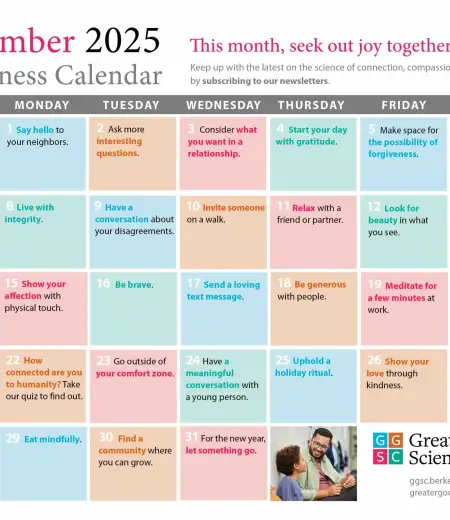Today, many of us are being exposed to graphically violent or harrowing imagery at a rate never experienced in the pre-digital age, from police shootings to bombings to floods and other climate disasters. Yet most social media users have never been taught how to safely engage with content that may be deeply upsetting. The photos and videos captured by mobile phones and uploaded by everyday social media users can be especially challenging: People post information that they think will grab attention, including that which is raw and emotive. And disturbing content may appear in our feeds at any time to surprise or unsettle us.

We started using science-based strategies for minimizing the harms of viewing graphic content when we launched the Human Rights Center Investigations Lab at UC Berkeley in 2016. From day one of the lab, our students were exposed to hundreds of videos from the war in Syria. Viewed to analyze and corroborate online information for human rights and legal organizations, these raw videos featured frightened people watching fighter planes dropping cluster bombs, distraught family members searching for loved ones, and homes leveled to rubble. Thanks to colleagues at Amnesty International, we knew from the get-go that we had to think about how to keep our students as safe as possible from secondary trauma or other ill effects.
Over time, the lab’s investigations have shifted from Syria to Myanmar to Sudan to the United States, and many other places where human rights violations and injustice persist. Throughout, we’ve continued to help students navigate the emotionally challenging and often graphic, painful imagery—learning a lot from them about what works and what doesn’t. Our aim has been to find alternatives to the tough-it-out route that is common for human rights investigators and journalists—and to acknowledge that traumatic imagery can affect us all through our exposure to news and social media.
In doing this work, we saw how the tactics used by professionals can be used by anyone who is attached to their phone and potentially swimming in graphic imagery. We are asking: How can we all stay engaged with what’s happening in the world while minimizing the risk of anxiety, depression, ruminations, or other negative effects? Our book, Graphic: Trauma and Meaning in Our Online Lives, explores this digital moment and includes suggestions collected from researchers and activists around the world for minimizing the potential harms of exposure to graphic online content.
Here are a few tips experts say are particularly effective.
Have a reason to look or watch. Start with being intentional about why you are viewing a potentially disturbing video or photograph on social media—even if this intention is simply to be engaged with the news of our world. Consider whether you can get the information in some other way, including through a medium that may not be as emotive or graphic as raw video, such as a newspaper article or other professionally packaged piece.
Be mindful. A mindfulness practice doesn’t need to be time-consuming or elaborate. Research shows that first responders and others who deal with stress and trauma day in and out benefit from mindfulness and breathing exercises. In terms of graphic social media content, this may mean taking just five minutes to step away from what you’ve seen for reflection, breathing, and grounding.
Turn the sound down—or off—the first time you watch a potentially disturbing video. The most upsetting content is often the audio: a child screaming for their parent, a woman begging for her life, a man crying out for his mother, a person spewing racist, misogynistic, or homophobic slurs. Turning the sound off (or way down) can help soften the emotional resonance.
Limit where you watch. Not all of us have options for where we view online content. However, for those who do, it can be helpful to create a dedicated space for engaging with upsetting social media. This can help prevent negative memories from contaminating those places you’d like to protect. It’s especially helpful to keep digital devices and the watching of graphic or other distressing content out of your bedroom. If you live in a studio apartment or other single-room space, even dedicating a corner for scrolling on social media (away from your bed!) can help.
 Graphic: Trauma and Meaning in Our Online Lives (Cambridge University Press, 2023, 240 pages)
Graphic: Trauma and Meaning in Our Online Lives (Cambridge University Press, 2023, 240 pages)
When possible, scroll through a video’s thumbnails to prepare yourself for what you’re about to see. Then, decide if you really want to see it—now or ever. Is “now” really the right time to watch? Are you about to go to bed? Should you maybe wait until morning, so the images and sounds don’t play on repeat while you struggle to fall asleep?
Make it smaller. If you know you’re going to watch something upsetting, minimizing the video’s size can lessen the impact. Is there a practical reason why you need to see someone killed on a large screen or can you get enough information by viewing something smaller?
Talk with others about what you’ve seen. We can’t “unsee” disturbing videos or photos, but we can discuss them. Researchers say releasing negative feelings after viewing something intense can help to dissipate potential long-term effects. In the absence of access to expert mental health support, peer-to-peer support can make a difference.
Move your body. After you’ve viewed upsetting material on your computer, tablet, or phone, whether for minutes or hours, it can help to move in order to process what you’ve experienced. Walking a dog, going for a run, taking a yoga class, blasting music, and having a one-minute solo “dance party” can all be ways to physically “metabolize” the stressful material to which you’ve been exposed. Some research suggests playing puzzle games like Tetris that require manipulation of objects can have a similarly protective effect.
Find ways to build community online and offline. The virtual worlds we dwell in can simultaneously bring us close to pain and suffering, yet remove us from actual people. Even though video conferencing is technically still virtual, it’s more interactive than posting and waiting for likes or comments. Ultimately, video chatting can enable people with similar passions and interests to connect—regardless of geography—sometimes even expanding communities. Connecting with friends, family, and community members offline and intentionally away from our technology is an essential way to reset.
Share a good laugh. Humor, even dark humor, has always been a means for coping with intense experiences, whether in a newsroom or operating room or on a battlefront. Researchers say laughter can be a psychological and even physiological release following exposure to trauma. Whether by binge watching a lighthearted show, taking in a romantic comedy, or streaming TikToks of cat life, humor can bolster our resiliency by acting as a valve for safely blowing off steam.
Be aware of your identities. Our identities—from race, gender, and sexuality to our roles as parents to our experiences as immigrants and beyond—can affect whether and how we identify with people being harmed. Our identities might make us more invested in knowing what’s happening to particular groups of people, but also more vulnerable to being overwhelmed by emotionally challenging posts. Being aware of how our overlapping identities or firsthand experiences of trauma may affect our reactions to social media content may prompt us to take extra care of ourselves, including by deploying some of the strategies above.







Comments